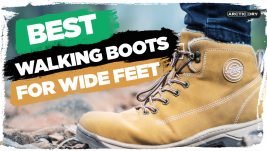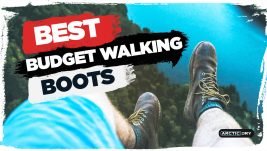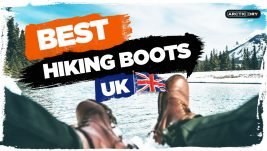What are the Lightest Walking Boots?

Contents
| Walking Boots | Price | Weight | View |
|---|---|---|---|
| Salomon X Ultra 3 Mid GTX | £108.99 | 450g | View |
| Merrell Moab 2 Mid Walking Boots | £251.32 | 936g | View |
| Keen Targhee III Mid Boots | £107.99 | 992g | View |
| Lowa Renegade GTX Mid Boots | £163.90 | 1110 g | View |
| Scarpa Zodiac Plus GTX | £266.83 | 1090g | View |
| Hoka One Sky Haka Toa GTX | £150.00 | 708g | View |
Exploring the great outdoors is one of our favourite things to do here in the UK, but the last thing you need while exploring is to take a heavy, dog eared pair of old walking boots around, weight you down..
If you’re a regular on the trails around the UK, then you’ll know that lightweight hiking gear can pay dividends when roaming around.
In this article we will delve into what materials to look for when purchasing a lightweight hiking boot, and the brands of hiking boot that we would personally recommend here at ArcticDry
Best Lightweight Walking Boots Buying Guide

Aside from weight, several other factors help to enhance your level of comfort while hiking. These are the features you should prioritise on a walking shoe when you go shopping around for one.
Whether you’re planning a short but intense hike lasting just half a day or a distant walk that will take you a couple of days, the following are questions you’ll need to answer when buying the best lightweight boots for walking for you:
What is the Best Fit for a Walking Boot?
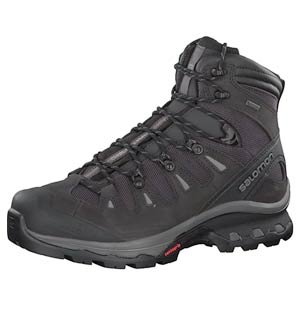 Determining the right fit for you will typically depend on if you have wide feet or narrow feet. If you have a relatively wider foot, going for shoes that fit too tightly means you run the risk of suffering blisters and rub spots during your hike.
Determining the right fit for you will typically depend on if you have wide feet or narrow feet. If you have a relatively wider foot, going for shoes that fit too tightly means you run the risk of suffering blisters and rub spots during your hike.
On the other hand, if your foot is narrow, wearing a loose-fitting shoe reduces the amount of support you get, as well as the level of stability. It’s quite easy to slide inside your shoes, especially on hilly and rocky trails.
So, for people with narrow feet, we suggest getting shoes with an appropriately narrow fit or medium width that you can lace up tightly.
You shouldn’t expose yourself to the danger of blisters by wearing loose shoes, especially if you tend to sweat on the feet during strenuous activities such as hiking. However, you can try and compensate for the loose fit by wearing a thicker pair of hiking socks to fill up that extra space.
Meanwhile, people with wider feet should opt for a brand that comes in a Wide Fit. This keeps you from getting squeezed inside your shoes and saves you discomfort. For ladies, a great trick you can use for wider feet is to try the men’s version of the shoes you plan to buy. This will typically be wider than the female’s version.
Do I Need Waterproofing in My Walking Boots?
Waterproofing is an essential feature in a hiking boot that helps to make it more practical on the trail. You want to consider what kind of weather conditions you’ll be hiking under to determine the need for a waterproof walking boot.
For instance, living in the UK, we get an absolute ton of rainfall throughout the year, even in the spring/summer, so investing in a pair of waterproof boots is well worth it.
But weather conditions aside, you are still likely to walk through mud puddles, water crossings, and even marshy land during a hike. So, the chances of coming into contact with wetness are still quite high.
Waterproof walking boots help to keep your feet dry and warm in case of rain, which helps to maintain your comfort during the hike. However, you want to make sure that the waterproof shoes you’re buying also come with an aspect of breathability for when the conditions are a little too hot.
What is the Ideal Lacing System for My Walking Boots?
 Unfortunately, laces are a feature that is normally overlooked by hikers when looking for the perfect boots!
Unfortunately, laces are a feature that is normally overlooked by hikers when looking for the perfect boots!
These play an important role when it comes to fit and comfort.
A shoe with a poor lacing system is prone to loosening after certain durations into your hike.
This can be very frustrating and forces you to keep on readjusting your laces constantly.
It can even expose you to the risk of hot spots and blisters. Sometimes, merely staring at the shoes may not be the right way to shop. If you have a poor lacing system on your shoes, this can easily be fixed by finding the correct replacement laces from the store.
Best Lightweight Walking Boots-Reviews

| Walking Boots | Price | Weight | View |
|---|---|---|---|
| Salomon X Ultra 3 Mid GTX | £108.99 | 450g | View |
| Merrell Moab 2 Mid Walking Boots | £251.32 | 936g | View |
| Keen Targhee III Mid Boots | £107.99 | 992g | View |
| Lowa Renegade GTX Mid Boots | £163.90 | 1110 g | View |
| Scarpa Zodiac Plus GTX | £266.83 | 1090g | View |
| Hoka One Sky Haka Toa GTX | £150.00 | 708g | View |
Salomon X Ultra 3 Mid GTX
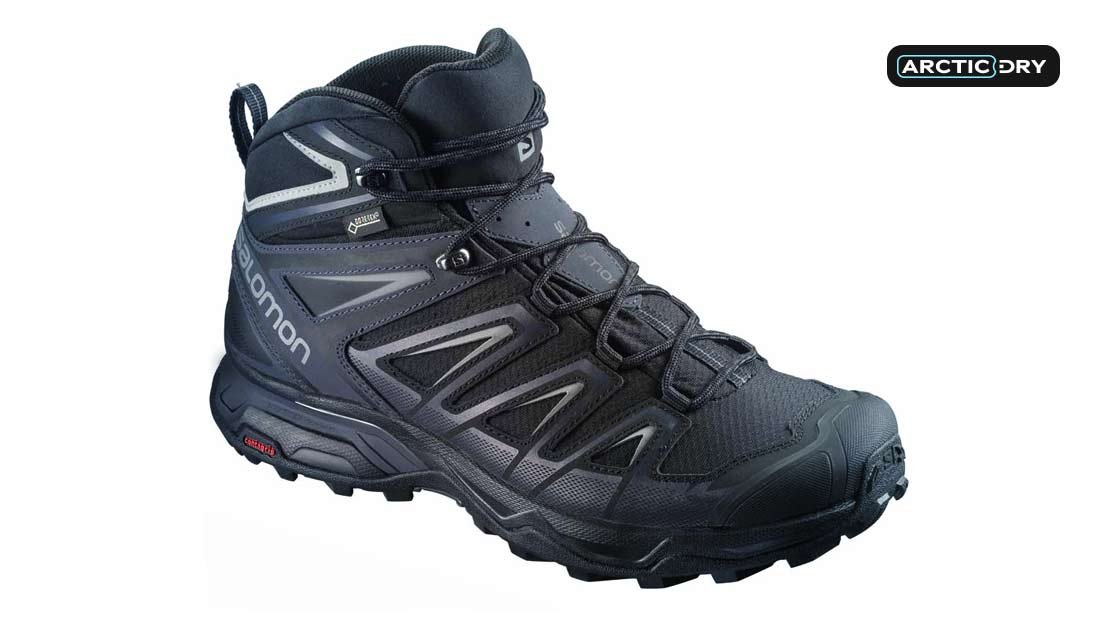
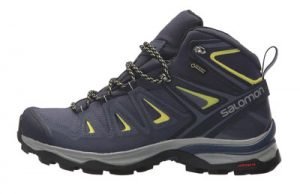 The Salomon X Ultra 3 GTX is engineered like a trail-running shoe but offers extra ankle support and protection on tricky terrain. It takes the number one spot on our list thanks to an array of practical features for a hiking boot.
The Salomon X Ultra 3 GTX is engineered like a trail-running shoe but offers extra ankle support and protection on tricky terrain. It takes the number one spot on our list thanks to an array of practical features for a hiking boot.
Overall, this pair of walking shoes offers a great balance between low weight and comfort, while still delivering solid toe protection, enhanced traction on slippery surfaces, as well as a stable chassis.
You also get to enjoy superior workmanship from Salomon that allows the shoes to cope with constant abuse on the trail better than other models in its price range.
The Salomon X Ultra weighs a little over 1lb! It is so lightweight that you’ll barely feel burdened even after hours of hiking.
This is what makes it such a great option for thru-hikers and day hikers who tend to move relatively faster with fewer stops.
The flat heel helps to keep you comfortable when you walk while the rubber sole provides a reliable grip on slippery and loose surfaces.
You’ll also appreciate the easy lacing system with eyelets used on the shoe. It allows for easy wearing of the shoes and holds your foot stably once done. A Gore-Tex membrane on the shoe allows for waterproofing capabilities yet remains breathable enough to keep you comfortable in hot environments.
Naturally, the lightweight boot design of the X Ultra means that there are a few compromises involved. The most notable is the underwhelming underfoot protection, which features a thinner inner sole that the Salomon Quest 4D.
Furthermore, these shoes are fairly flexible and don’t rise high up the ankle. As such, they may not offer the kind of support you need to hike in technical terrains with a heavy backpack.
Nevertheless, they come to their own as far as durability, comfort, and traction are concerned. If you still want to cut more weight on the shoe, the X Ultra also comes in a low-top design!
Merrell Moab 2 Mid
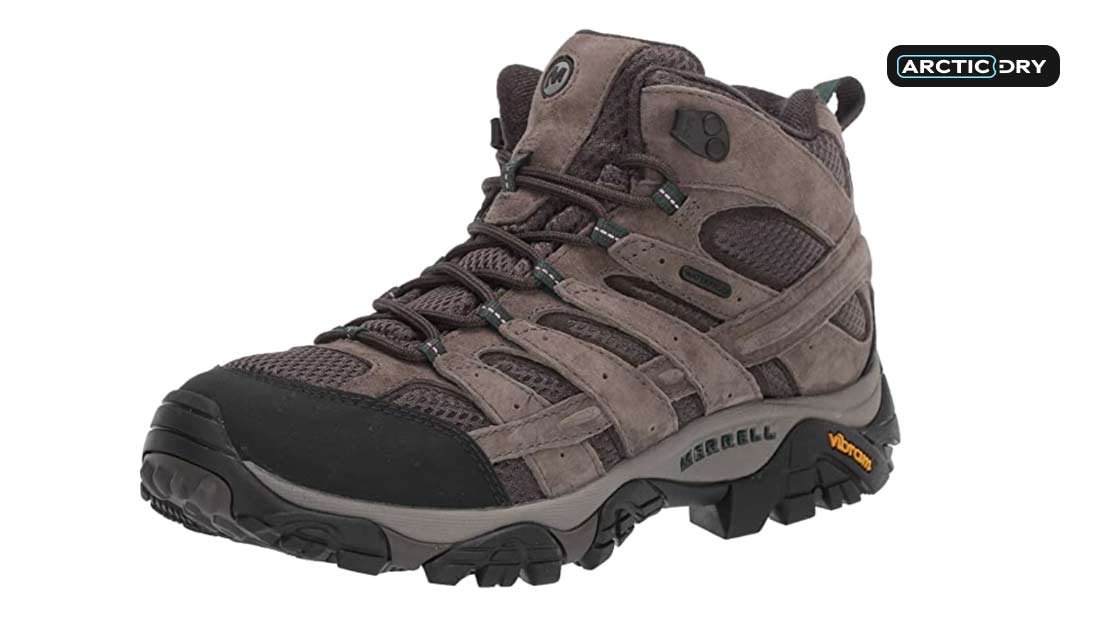
The Moab 2 Mids from Merrell were designed for lightweight backpackers and day hikers who like to venture into relatively lighter trails.
The boots are conveniently lightweight to maximise your comfort during a hike and you can acquire them at a very reasonable price. Your comfort when wearing the Moab 2 Mids is taken care of by decent underfoot cushioning, as well as a flat heel type that works well on generally flat rails.
A waterproof membrane is included to keep your feet dry and warm in case of light showers. Meanwhile, the high-quality Vibram soles help to keep you on your twos by offering reliable traction when the surface gets slippery.
These shoes were upgraded a couple of years ago to include a new, more comfortable insole with improved cushioning and a higher arch. A mesh design on the outer shell serves to facilitate free airflow to let your feet breathe when it gets hot.
The lace-up system is also easy to work and provides a fit that holds your foot sturdily in place.
Other than that, the Moab 2 Mids are a reliable hiking boot if you are looking to take on friendly walking trails. Despite the cost-friendly price tag, it comes with the ideal mix of performance and comfort for your day hikes or weekend adventures. For those who prefer to hike in warmer and drier environments, there is a non-waterproof version of the shoe that offers better breathability – the Moab 2 Mid Ventilator.
Keen Targhee III Mid

These are some of the best lightweight hiking boots the market has to offer. They feel great straight out of the box and come at a price that will take it easy on your wallet.
The Keen Targhee line is quite popular among moderate backpackers and day hikers, thanks to a combination of practical features. Firstly, these hiking boots are very lightweight and tip the scale at just over 2lbs.
This lets you remain mobile on the trail without dragging you down with premature fatigue. They also come with a relatively wide fit, meaning they may not be a good choice for narrow feet.
The toe box offers ample room to wriggle your digits and keep them from getting numb. You’ll also appreciate the tough constructions of the Targhees, which is highlighted by a good-sized toe cap, to go with a sturdy leather upper that rises just over the ankle to provide reliable rollover protection.
You also get decent ankle support on friendlier trails while the rubber soles grip nicely for maximum stability on unstable surfaces. These shoes are also waterproof, so you won’t have to worry in case of surprise showers in the middle of the trail. The leather outer also delivers a durable performance than most models in this price range.
The only thing about the leather construction is that it adds a bit of weight to the Targhees compared to other lightweight walking boots. Nevertheless, the shoes are very manageable and their mesh design allows for some good level of breathability.
This means your feet remain cool and fresh while saving you the discomfort that comes with sweaty feet. Finally, the fact that you can get it for less than 100 pounds makes the Targhee III Mid one of the best lightweight walking boots around.
Lowa Renegade GTX Mid
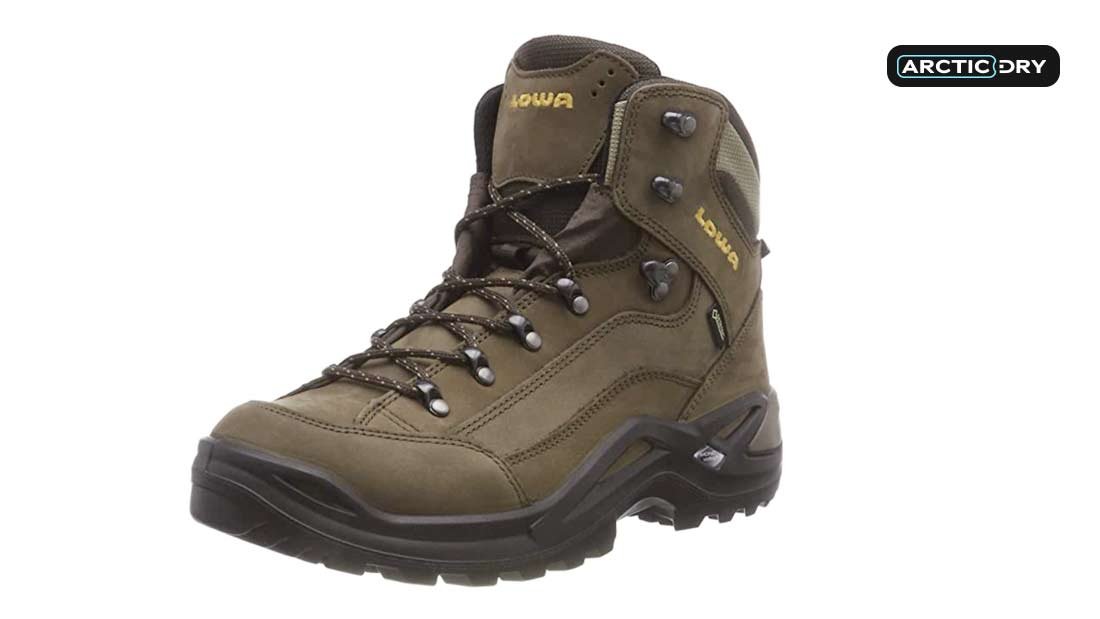
The Renegade GTX Mids have the look and feel of a hiking boot, featuring a Nubuck leather construction. They are pretty lightweight and nimble on the road; you’ll barely feel the 2lbs of the shoes weighing you down.
Unlike other walking shoes in this price range, the Renegades offer enhanced isolation from the ground, which makes your steps feel more planted and stable. This helps to keep you comfortable while hiking and comes in handy when you have a heavy load on your back.
A polyurethane Monowrap frame in the midsole makes for a more stable performance. The wight of the shoe was reduced by the relatively thin leather upper that serves to reduce the break-in period.
Meanwhile, the high-quality Vibram Evo outsole does a great job of keeping you vertical when on slippery climbs. You’ll also like the user-friendly lacing system that saves you time when wearing or removing the boots.
The sacrifice of weight on the Renegades comes with its own cons. The major one being that these shoes don’t hold up well over time. High-mileage users claim that they had to replace the pair in less than a year, although they find themselves remaining loyal to the boots because of the nice balance of support and weight.
Furthermore, the fit is pretty flexible since you can find the shoes in narrow, wide, and regular.
Scarpa Zodiac Plus GTX
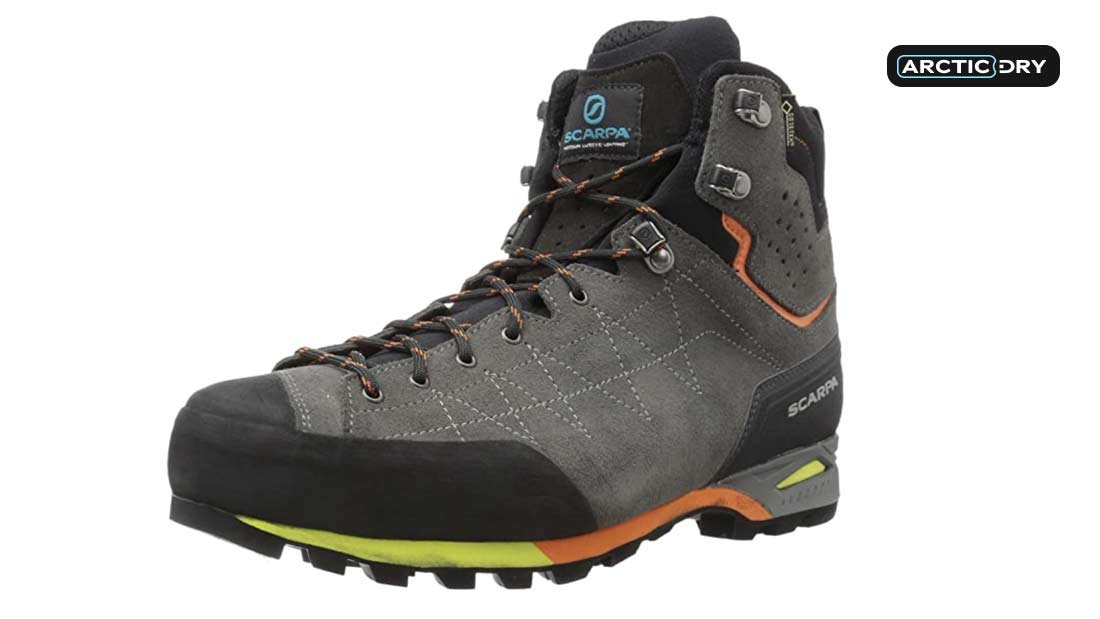
The Scarpa Zodiac Plus lightweight enough to let you hike for hours without getting fatigued yet tough enough to take on rocky and boulder-filled trails. It boasts a versatile design that holds well on various terrains thanks to a smart mix of functional hiking features.
These shoes feature a polyurethane material on the outer shell that is lined with a Gore-Tex membrane to make it waterproof.
Despite this, the material is breathable to ensure keep you comfortable when your feet start to sweat.
The Zodiacs also impress with a semi-stiff build and high-quality construction that offers solid protection when dealing with steep climbs and tricky descents.
You can credit this to the rubber sole, which is not only bouncy to absorb shock but also quite grippy to ensure maximum stability on the surface. Furthermore, a Sock-Fit DV construction helps to reduce bulkiness and deliver a snug fit for your walking comfort.
You also get an asymmetrical lace system to enhance the fit and hold your foot in place to prevent sliding inside the boot. Meanwhile, three densities of EVA in the midsole serve to cushion you on rough surfaces and reduce the impact on your underfoot. Another useful feature is the 360-degree rubber rand, which makes for improved protection in colder hiking conditions.
Hoka One Sky Haka Toa GTX

This is one walking boot that will impress you with its fun colours. The Hoka One One brand is revered for its lightweight and cushioned range of outdoor walking gear.
The Hoka One Sky Toa sits high on the pecking order, which is a credit to its practical construction. This boot comes with a comfortable springy midsole that adds to your step on the trail. Its Gore-Tex waterproof upper serves to protect your feet in wet hiking conditions.
It also extends over the ankle to deliver needed ankle support while the flexible overall construction ensures that you remain at ease throughout your adventure. However, there isn’t enough support to enable carrying of super heavy loads or hiking on rough trails.
A mesh design on the outer shell allows for interrupted airflow so that your feet remain fresh and cool when the temperatures rise.
The rubber sole also features seep lugs that grip on the surface to improve traction, ensuring that you avoid falls in slippery conditions and ankle sprains. In the end, the Hoka One Sky Toa is a nice example of what that manufacturer’s comfort-first, max-cushioned ethos is all about. You’ll have no regrets picking it for your light hiking adventures.
Conclusion
If you want to make the most of your hiking adventure, comfort should be at the top of your priorities. This is something you can achieve by going for a lightweight and well-constructed pair of hiking boots.
It is also a great way to maintain mobility on the trail and not have to worry about fatigue. The reviewed models are some of the best lightweight walking shoes the market has to offer and will make a nice option for both experienced and rookie hikers.
FAQ
What is the Difference Between Walking Boots and Walking Shoes?
Many people find it hard to tell walking boots and walking shoes apart, which can be quite confusing when you go shopping given that they are sold side by side. The thing about walking boots is that they are better suited for hill walkers because of their sturdy and versatile construction.
Most of them are waterproof and breathable with ample ankle support that will be great for rougher terrains.
On the other hand, walking shoes are recommended for day hikers and short-distance walkers on well-maintained trails. They tend to be more lightweight with a lot of focus on the comfort of the user, which makes them ideal for easy-going terrains.
Their general construction includes limited waterproofing and breathable capabilities while the ankle support is also wanting. Overall, you want to use walking shoes in relatively warm and dry conditions.
How Do I Avoid Blisters When Choosing a Walking Boot?
Blisters are a common occurrence for hikers, especially those who have sweaty feet. They are generally caused due to friction against the skin, as well as hiking socks slipping and bunching.
The situation gets worse when your feet get moist and soften. Luckily, the position of the blister can point out its cause. For instance, if your blister is on the heel, it means the shoe’s heel cup is too wide. Meanwhile, if it’s on the top of your toes, this points to the shoes being too long.
The best way to avoid blisters is to get a pair of walking boots that fit you just right. This implies that you shouldn’t settle for too wide or too tight a pair.
If possible, try on as many pairs of your preference while still at the store until you find the right one.
In some cases, the pair of boots will have to be broken into, which may take a few days or weeks, depending on how often you use them. Furthermore, you can wear your shoes with moisture-wicking socks to get rid of the wetness inside.
Do Walking Boots Require Breaking In?
Many designs of walking boots need to be broken into, and the construction material goes a long way to determine this. However, the shoes you choose should ideally provide a nice fit straight out of the box.
Leather boots, for instance, will typically need to be worn a few times before they feel comfortable. One thing manufacturers do to solve is waterproofing them to stretch the leather. It helps to make them more supple and comfortable to wear.
Alternatively, you can use a leather softener if you’re finding it hard to break into your leather boots.
Even though lightweight boots don’t require breaking into because of their softer fabric and mesh panels, the leather uppers do. Also, off-trail shoes may take more time for the heel cap and sole to soften. Lastly, some shoes can be hard to break into, but this is not always a bad thing. It is simply a sign that you have invested in a durable pair of walking boots that will deliver tough performance down the line.




